 Farm Progress has re-designed their websites. They’re calling it a new “internet portal.”
Farm Progress has re-designed their websites. They’re calling it a new “internet portal.”
Farm Progress has redesigned its state and regional magazines’ Web sites to provide readers with a more feature-packed and flexible Internet portal. The introduction is more than a redesign and its functionality is not found elsewhere in agricultural media Web sites. The sites have a totally different look, feel and experience.
The internet portal thing makes me have to make a comment. Does that term still make sense in today’s new media world? I think it suggests an all-inclusive environment where the visitor never leaves because the site contains all they need. After a quick look, it does indeed contain a lot of information but . . . I think today’s web savvy farmers and ranchers surf all over the place and go to places that are their favorites for various kinds of information. Let’s take weather for example. How about Weather.com or AccuWeather.com? How about sports (ESPN, Sports Illustrated)? How about market prices (CME Group, MGEX)? What do you think about the portal concept?
Zimfo Bytes
- More than 500 growers and retailers were at the Iowa Speedway in Newton, Iowa, on Sept. 3 to learn about innovations in agriculture. The day’s theme was “Race to Innovation.” After a lunch break, growers and retailers participated in informational sessions that reviewed the current agribusiness landscape, as well as specific innovations in the Bayer CropScience pipeline.
- WATT Poultry announces the release of the 2008-09 Executive Guide to World Poultry Trends. The comprehensive guide, updated each year, takes current economic trends into account for predicting poultry companies’ challenges over the next year, including oil prices, cost of feed and industrial demand.
- Cantaloupe grower Steve Sumner, Georgia, Attributes Improved Yield and Quality
to StollerUSA’s Flower Power. A cursory count in one field indicated a harvest of 13,500 to 14,000 premium quality melons per acre. Sumner estimates a 15-20% yield increase over last year’s crop and attributes much of that to Flower Power. - Asoyia Inc. will receive a $300,000 grant from the USDA. Iowa City-based Asoyia was one of 144 recipients in 37 states to receive USDA Rural Development assistance under the Value-Added Producer Grant program.

Flex Symposium Full
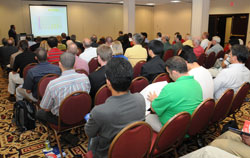 The Boehringer Ingelheim Flex Symposium is underway in St. Paul, MN.
The Boehringer Ingelheim Flex Symposium is underway in St. Paul, MN.
We’ve got several presentations taking place right now and I’ve already interviewed all of them. I’ll probably be posting them by Monday since I’ll be traveling home on Sunday.
We had to bring in more chairs because the attendance at this year’s Symposium is larger than expected. Now isn’t that what you want?
Of course there is a photo album and you can find it here: Boehringer Ingelheim Flex Symposium Photo Album
Austrian Hog Farming
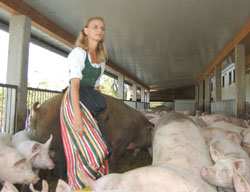 Bring a wafer-thin slice of Vulcano to your mouth and savour the magnificent aroma of the dry-cured ham before allowing the full taste to develop on your tongue. That’s the translated version of the sales pitch for Vulcano Ham company in Austria.
Bring a wafer-thin slice of Vulcano to your mouth and savour the magnificent aroma of the dry-cured ham before allowing the full taste to develop on your tongue. That’s the translated version of the sales pitch for Vulcano Ham company in Austria.
This was our last stop before leaving Austria for Slovenia on the 2008 IFAJ Congress trip and it was an interesting one. In the photo you see Bettina Habel, the wife of one of the three main proprietors of Vulcano, mingling with the herd at the farm, including big Leo (who is the “mascot” of the operation and not for consumption!)
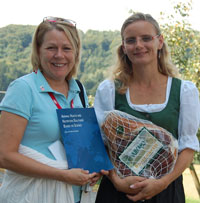 Vulcano specializes in air-cured hams that are sold for a premium only to high-end consumer markets. The regional trademarked product is manufactured from hoof to ham in the same location.
Vulcano specializes in air-cured hams that are sold for a premium only to high-end consumer markets. The regional trademarked product is manufactured from hoof to ham in the same location.
I was happy to be able to put a brochure from one of our sponsors, Novus International, in Bettina’s hands, as well as give one to their veterinarian who was our local guide and interpreter for the visit. They did seem interested in the animal health and feed products Novus offers for hog producers – and I pointed out that their website is also available in several languages, including German!
Sound of MOOsic
One of the highlights of the 2008 IFAJ Congress in Austria was the visit to a traditional mountain farm. All of the participants in that tour just raved about the pastoral scenery on such a perfect day they expected to see Julie Andrews dance up over the hillside singing the “Sound of Music.”
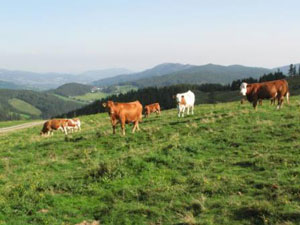 Unfortunately, Chuck and I did not get to go on that tour, as it was sold out immediately. There were three different tour options for the trip, which is really kind of a shame – everyone would have enjoyed getting to see this.
Unfortunately, Chuck and I did not get to go on that tour, as it was sold out immediately. There were three different tour options for the trip, which is really kind of a shame – everyone would have enjoyed getting to see this.
These pictures were provided by one of our Canadian friends, Lilian Schaer of Agri-Food Project Services Ltd. She and Kelly Daynard with the Ontario Farm Animal Council both went on that tour and wrote about it on the blog, Food and Farming Canada.
Lilian wrote: Much of Austria is covered in pastoral mountainside fields – beautifully scenic but largely unsuited for agriculture.
But in the mountainous northern regions of the Austrian province of Styria, some entrepreneurial farmers are not only making a living by farming on the alpine pastures, they’re also revitalizing rural communities and keeping ancient traditions alive.
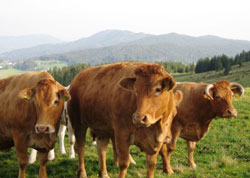 In Kelly’s post, she began: High up in the mountains, the scenery fulfilled every stereotype I’ve ever had about this country. Cow bells could be heard in the distance. A babbling brook twisted alongside the roadway. Every home was a flower-laden chalet and, to the eye’s delight was mountain after mountain after mountain. I could have stayed there forever.
In Kelly’s post, she began: High up in the mountains, the scenery fulfilled every stereotype I’ve ever had about this country. Cow bells could be heard in the distance. A babbling brook twisted alongside the roadway. Every home was a flower-laden chalet and, to the eye’s delight was mountain after mountain after mountain. I could have stayed there forever.
What made it even more unusual was that we were touring an average mountain beef farm. I’ve been to a lot of impressive beef farms in Ontario but none have the view of these, to be sure.
Be sure to check out the rest of their blog posts to read their impressions about the trip. Thanks for sharing the photos, my friends!
Boehringer Ingelheim Flex Symposium
 This afternoon Boehringer Ingelheim will be holding a “Flex Symposium.” I’ll be attending to conduct some interviews and take pictures.
This afternoon Boehringer Ingelheim will be holding a “Flex Symposium.” I’ll be attending to conduct some interviews and take pictures.
Our program includes:
PCVAD Scientific Overview – Dr. Edgar Diaz
Pig Performance with Ingelvac MycoFLEX® vs. Two-dose Vaccines – Dr. John Kolb
Impact of PCV2 Vaccination on Subclinical PCVAD Cases in Canada, France and U.S. – Dr. Emest Sanford
Qualifying Animal Responses to Various Immunization Protocols – Dr. Keith Bretey
Behind the Scenes – Research and Development of Ingelvac® CircoFLEX-MycoFLEX™ – Dr. Petra Maass
Announcement and Presentation of the 2008 PCVAD Research Awards
Traditional Slovenia Dancing
I mentioned traditional Slovenian dance in an earlier post and that’s what we saw at our final dinner of the IFAJ Congress.
Farm Aid Today
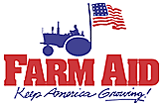 If you’re looking for something to watch today besides college football, then you might want to tune in to Farm Aid.
If you’re looking for something to watch today besides college football, then you might want to tune in to Farm Aid.
Farm Aid 2008 Presented by Whole Foods Market and Horizon Organic is today! Doors open at noon and the music starts shortly after. If you’re not coming to the show, watch all the action on in HD on DIRECTV or on FarmAid.org. Both broadcasts start at 4pm and will be live until 11pm with no commercials!
Dancing To Quasimojo
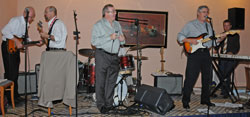 I don’t know when the first Quasimojo performance was at an IFAJ event but they’re still going strong.
I don’t know when the first Quasimojo performance was at an IFAJ event but they’re still going strong.
This year’s Congress found them playing on stage after our final dinner in Portoroz, Slovenia. We had just finished all the speeches and awards and were full and it was late. The band has a kind of flexible membership and somehow seems to crank out the same great music to entertain us.
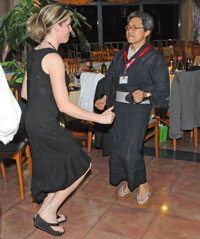 Our program for the final dinner called for some “traditional dancing.” That’s something I’ll have in a different post.
Our program for the final dinner called for some “traditional dancing.” That’s something I’ll have in a different post.
While Quasimojo was playing however, we had anything but traditional dance. This pictures shows the international understanding of how to dance to rock and roll though.
Pumpkin Seed Oil
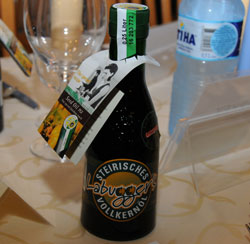 A year before the IFAJ Congress 2008 we were given packets of pumpkin seeds to plant and then we were supposed to send in or bring photos of our pumpkin plants. I tried but let’s just say growing pumpkins isn’t one of my things.
A year before the IFAJ Congress 2008 we were given packets of pumpkin seeds to plant and then we were supposed to send in or bring photos of our pumpkin plants. I tried but let’s just say growing pumpkins isn’t one of my things.
We saw lots of pumpkin fields but never got to visit any when we were in Austria. However, at our last dinner we did receive a bottle of pumpkin seed oil.
Now if I could just get home to use it with some new culinary feast.


